Latics of the Prophet Mohammed
(Quran. Surah the second. The Cow (Al-Baqarah). Meaningful translation into Russian by E. Kuliyev)
Even the Roman emperors made it a rule to recruit from the Arabs, the inhabitants of the Arabian Peninsula, auxiliary units of light cavalry. Following them, the Byzantines continued this practice. However, reflecting the attacks of nomads in the north, they could hardly even imagine that in the first half of the 7th century numerous Arab armed forces, moving on camels, horses and on foot, would break out of Arabia and turn into a serious threat to them in the south. In the late 7th and early 8th centuries, a wave of Arab conquerors seized Syria and Palestine, Iran and Mesopotamia, Egypt and areas of Central Asia. In their campaigns, the Arabs reached Spain in the west, the Indus and Syr Darya rivers in the east, in the north - the Caucasus Mountains, and in the south they reached the shores of the Indian Ocean and the barren sands of the Sahara desert. On the territory they conquered, a state emerged, united not only by the power of the sword, but also by faith - a new religion, which they called Islam!
Muhammad (on horseback) receives the consent of the clan Beni Nadir to withdraw from Medina. A miniature from the book of Jami al-Tawarih, written by Rashid al-Din in Tabriz, Persia, 1307 AD.
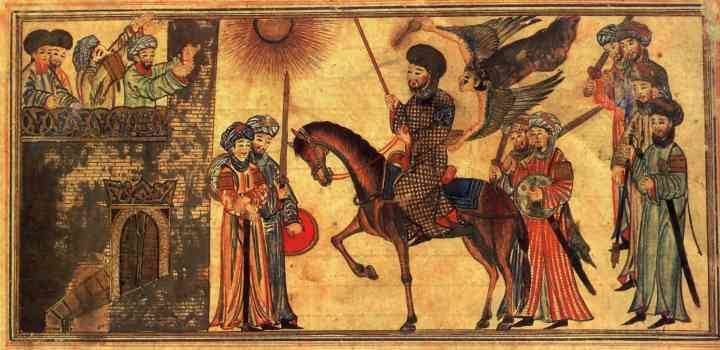
But with what did the unprecedented rise of military affairs from the Arabs, who in a short time managed to create a greater power than the empire of Alexander the Great, was connected with? There are several answers here, and all of them, one way or another, stem from local conditions. Arabia - for the most part, desert or semi-desert, although here there are extensive pastures suitable for horses and camels. In spite of the fact that there is not enough water, there are places where it is sometimes necessary to just scoop up the sand with your hands to get to the subterranean waters. In the south-west of Arabia, there are two rainy seasons each year, so sedentary agriculture was developed there from ancient times.
Among the sands where water made its way to the surface, there were oases of date palms. Their fruits along with camel's milk served as food for the nomadic Arabs. The camel was also a major source of livelihood for the Arab. They even paid for the murder with camels. For a man killed in a fight, it was required to give as many as one hundred camels to avoid blood feuds from his relatives! But the horse, contrary to popular belief, did not play a significant role. The horse needed good food, and most importantly, plenty of clean, fresh water. True, under the conditions of starvation and lack of water, the Arabs taught their horses to feed on anything — when there was no water, they were given milk from camels, fed them dates, sweet cakes and even ... fried meat. But the Arabian horses did not learn to eat camel feed, so only very wealthy people could keep them, while camels were accessible to everyone.
The entire population of the Arabian Peninsula consisted of separate tribes. At the head of them, like the northern nomads, were their leaders, who were called sheikhs by the Arabs. They also had large herds, and in their tents, covered with Persian rugs, one could see a beautiful harness and a precious weapon, beautiful utensils and delicious treats. The tribal enmity weakened the Arabs, and especially the merchants had a bad life, the essence of which was the caravan trade between Iran, Byzantium and India. Ordinary nomadic Bedouins plundered caravans and sedentary peasants, due to which the rich Arab elite incurred very heavy losses. Circumstances demanded an ideology that would smooth social contradictions, put an end to the anarchy that prevailed and directed the pronounced militancy of Arabians to external goals. Mohammed gave it to her. Initially, ridiculed for obsession and surviving the blows of fate, he managed to unite his fellow countrymen under the green banner of Islam. This is not the place to discuss this respected person who openly admitted his weaknesses, refused the glory of a miracle worker and understood the needs of his followers well, or talked about his teaching.
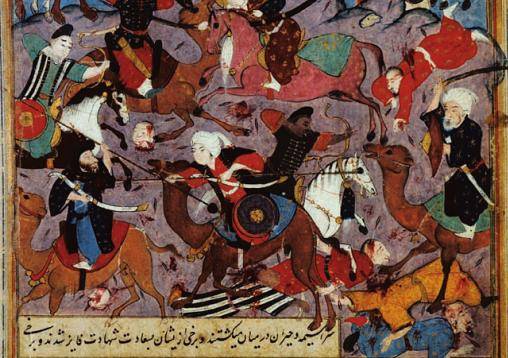
Mohammed's army fights with the Meccan army in 625 g in the battle of Uhud, in which Muhammad was wounded. This miniature is from a Turkish book around 1600 of the year.
For us, the most important thing is that unlike other, earlier religions, including Christianity, Islam turned out to be much more specific and convenient, first of all, because first of all it established the order of life on earth, and only then promised someone paradise and to whom and the afterlife torments in the next world.
The refusal of pork, wine, gambling and the usury, which ruined the poor, also corresponded to the moderate tastes of the Arabs. Religious affairs were recognized as commerce and, which was very important for militant Arabians, a “holy war” (jihad) against the infidels, that is, non-Muslims.
The spread of Islam and the unification of the Arabs happened very quickly, and troops were already equipped to march on foreign countries when the Prophet Mohammed died in 632. But not lost to the Arabs immediately chose his "deputy" - the Caliph, and the invasion began.
Already during the second caliph Omar (634 – 644) the holy war led Arab nomads to Asia Minor and the Indus valley. Then they seized fertile Iraq, western Iran, and established their rule in Syria and Palestine. Then came the turn of Egypt - the main breadbasket of Byzantium, and at the beginning of the VIII century of the Maghreb - its African possessions to the west of Egypt. After which the Arabs conquered most of the kingdom of the Visigoths in Spain.
In November 636, the Byzantine army of Emperor Heraclius attempted to defeat the Muslims in a battle on the Yarmuk River (a tributary of the Jordan) in Syria. It is believed that the Byzantines had 110 of thousands of warriors, and the Arabs had only 50, but they attacked them decisively several times in a row, and finally broke their resistance and turned them to flight (See Nicolle D. Yarmyk 630 AD.) Muslim conguest of Syria. L .: Osprey, 1994)
The Arabs lost 4030 people killed, but the losses of the Byzantines were so great that their army almost ceased to exist. Then the Arabs laid siege to Jerusalem, which surrendered to them after a two-year siege. Along with Mecca, this city became an important shrine for all Muslims.
One after another, the dynasties of the caliphs succeeded each other, and the conquests continued and continued. As a result, by the middle of the eighth century. a truly grand Arab Caliphate * was formed - a state with a territory many times larger than the entire Roman empire, which had significant territories in Europe, Asia and Africa. Several times the Arabs tried to take Constantinople and kept him under siege. But the Byzantines managed to repel them on land, while at sea the Arab fleet they destroyed by "Greek fire" - a combustible mixture, which included oil, because of which it burned even on water, turning the ships of their opponents into floating fires.
It is clear that the period of the victorious wars of the Arabs could not last forever, and already in the VIII century their advance to the West and East was stopped. In 732, at the Battle of Poitiers in France, the army of Arabs and Berbers was defeated by the Franks. In 751, near Talas (now the city of Jambul in Kazakhstan), the Chinese won over them.
Caliphs for a special tax guaranteed the local population not only personal freedom, but also freedom of religion! Christians and Jews were also considered (as adherents of monotheism and “people of the Book”, i.e. the Bible and the Koran) rather close to Muslims, while pagans were subjected to merciless persecution. This policy turned out to be very reasonable, although the Arab conquests were mainly promoted not so much by diplomacy as by the strength of the weapon.
Arab warriors should not be considered at all only as horsemen, wrapped from head to toe in all white, and with crooked sabers in their hands. Let's start with the fact that they did not have any curved sabers then! All Muslim warriors depicted in the Arabic miniature 1314 - 1315. near the prophet Muhammad during his march on Heybar Jews, armed with long and straight double-edged swords. They are already, than the modern Europeans swords, they have a different crosshair, but these are indeed swords, and not sabers at all.
Practically all the first caliphs also had swords that survived to the present day. However, judging by the collection of these blades in the Istanbul Topkapi Palace Museum, the Prophet Mohammed still had a saber. It was called “Zulfi-kar”, and its blade was with elmanju — the broadening located at the end of the blade, the severity of which gave the blow much greater force. However, it is believed that it is not actually of Arab origin. One of the Caliph Osman’s swords also had a straight blade, although it has one blade, like a sword.
Interestingly, the banner of the prophet Muhammad at the very beginning was also not green, but black! All other Caliphs, as well as various Arab tribes, had the appropriate color banners. The first were called “live”, the second - “paradise”. One and the same leader could have two banners: one - own, the other - tribal.
We also will not see any protective weapons, except for small round shields, on the above miniature among the Arabs, although this does not mean anything. The fact is that wearing protective armor under clothing was widespread in the East even more widely than in Europe, and the Arabs were no exception. It is well known that the Arab masters were famous not only for their melee weapons, which they produced from Indian Bulat, but also for chain armor **, the best of which were made in Yemen. Since Islam forbade images of people and animals, the weapon was decorated with floral ornaments, and later in the XI century - with inscriptions. When Damascus became the main city of the Muslim world, it became the center for the production of weapons.
It is not for nothing that blades made of especially high-quality steel covered with patterns were commonly called Damascus, although they were often made in various places. The high qualities of Damascus steel were explained in the East not only by the technology of its production, but also by a special method of metal hardening. The master, removing the red-hot blade with a forceps, passed it to the rider, who was riding his horse at the door of the workshop. Taking the blade, squeezed into the tongs, the rider, without losing a second, let the horse fly at full speed and raced like the wind, allowing air to flow around it and cool it, resulting in hardening. The weapon was richly decorated with gold and silver notch, precious stones and pearls, and in the VII century, even in excessive quantities. The Arabs especially liked turquoise, which they received from the Sinai Peninsula, as well as from Persia. The cost of such weapons was extremely high. According to Arab sources, a perfectly worked sword could cost up to a thousand gold denarii. Considering the weight of the gold dinari (4,25 g), it turns out that the cost of the sword was equivalent to 4,250 kg of gold! In fact, it was a fortune.
The Byzantine emperor Leo, reporting on the army of the Arabs, mentioned only one cavalry, consisting of horsemen with long spears, horsemen with throwing spears, horsemen with bows and heavily armed horsemen. Among the Arabs themselves, horsemen were subdivided into al-Muhajirs — heavily armed and al-Sansars — lightly armed soldiers.
However, there was infantry in the Arab army. In any case, at first the Arabs lacked horses so much that in 623, during the Battle of Badr, two people sat on each horse, and only later did the number of riders increase. As for heavy armor, hardly anyone of the Arabs wore them all the time, but in battle the entire stock of protective weapons was used. Each cavalry had a long spear, a mace, one or even two swords, one of which could be a konchar - the same sword, but with a narrow three- or four-sided blade, the most convenient for defeating the enemy through ringed armor.
Acquainted with the military affairs of the Persians and Byzantines, the Arabs, like them, began to use horse armor, as well as protective shells made of metal plates, tied together and worn over the chain mail. Interestingly, the Arabs did not know the stirrups at first, but very quickly learned how to use them, and they themselves began to manufacture first-class stirrups and saddles. The cavalry of the Arabs could dismount and fight on foot, using their long spears as a peak, like that of the Western European infantry. In the era of the Umayyad dynasty Arab tactics resembled Byzantine. Moreover, their infantry was also divided into heavy and light, consisting of the poorest Arab archers.
The main striking force of the army of the Caliphate was cavalry during the Abbasid dynasty. She was a heavily mounted horse archer in chainmail and lamellar shells. The shields they had were often of Tibetan origin from perfectly tanned leather. Now, most of this army was made up of Iranians, not Arabs, as well as immigrants from Central Asia, where at the very beginning of the 9th century an independent state of Samanids was formed, breaking away from the caliphate of the rulers of Bukhara. Interestingly, although by the mid-10th century the Arab caliphate had already broken up into a number of individual states, the decline of military affairs did not occur among the Arabs.
There were fundamentally new troops, consisting of the ghouls - young slaves, specially purchased for use in military service. They were thoroughly trained in military affairs and armed with funds from the treasury. At first, the ghouls played the role of the Praetorian Guard (personal bodyguards of the emperors of Rome) under the person of the Caliph. Gradually, the number of gulyams increased, and their units began to be widely used in the army of the caliphate. Poets who described their weapons, noted that it shone as if "consisting of many mirrors." Historians-contemporaries noted that it looked “similar to Byzantine,” that is, people and horses were dressed in armor and blankets of metal plates (Nicolle D. Armies of the Caliphates 862 - 1098. L .: Osprey, 1998. P. 15).
Now the Arab troops were an army of people who had a single faith, similar customs and language, but continued to maintain their national forms of weapons, the best of them gradually adopted by the Arabs. From the Persians they borrowed the sheath of swords, in which, besides the sword itself, were placed darts, a dagger or a knife, and from Central Asia - a sword ...
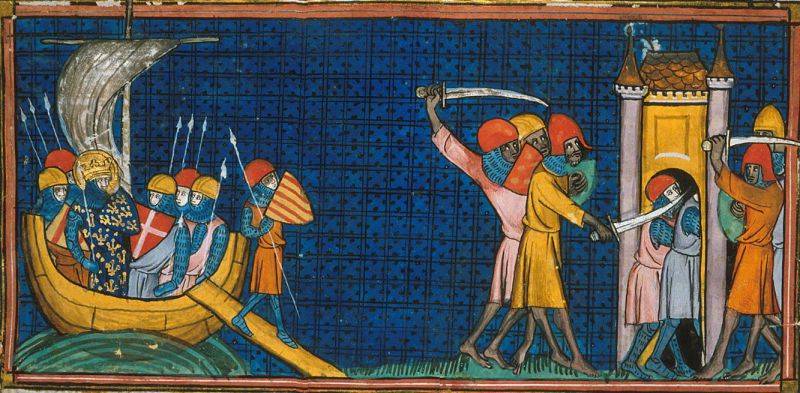
The eighth crusade 1270, the Crusaders of Louis IX land in Tunisia. One of the few medieval miniatures on which eastern warriors are depicted with sabers in their hands. Miniature from the Chronicle of Saint-Denis. Around 1332 - 1350 (British Library)
In the battle, complex tactical structures were used, when infantry made up of spearmen were put in front, followed by archers and dart throwers, then cavalry, and (when it was possible) fighting elephants. The cavalry of the ghouls was the main striking force of such a structure and was located on the flanks. In battle, the first thing used was a spear, then a sword, and finally a mace.
Horse detachments were divided by weight of armor. Riders had monotonous weapons, as warriors on horsebacks with protective shells made of metal plates could hardly be used to pursue a retreating enemy, and felt blankets of lightly-armed riders were not sufficient protection from arrows and swords during an attack against infantry.
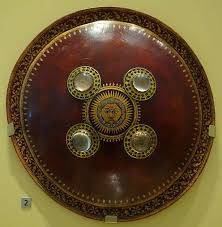
Indian shield (dhal) of steel and bronze. Empire of the Mughal. (Royal Ontario Museum, Canada)
In the Maghreb countries (in North Africa) the influence of Iran and Byzantium was less noticeable. Local types of weapons were preserved here, and the Berbers, the nomads of North Africa, even though they converted to Islam, continued to use light darts, not heavy spears.
The way of life of the Berbers, known to us from the descriptions of travelers of that time, was closely related to the conditions of their existence. Any nomad from distant Mongolian would find here almost the same thing as in his homeland, in any case, the orders there and here were very similar.
“The king ... gives people an audience in the tent to handle incoming complaints; around the tent during the audience there are ten horses under gilded blankets, and behind the king are ten young men with leather shields and swords decorated with gold. To his right are the sons of the nobility of his country in beautiful clothes, with golden threads woven into their hair. The ruler of the city sits in front of the king on the ground, and the viziers sit around him also on the ground. At the entrance to the tent - pedigreed dogs with gold and silver collars, which are attached a lot of gold and silver badges; they do not take a close look from the king, protecting him from any encroachment. On the royal audience reported drumming. A drum called a dub is a long, hollow piece of wood. Approaching the king, his co-religionists fall to their knees and dust their heads with dust. Such is their greeting to the king, ”said one of the travelers who visited the Berber tribes of North Africa.
African black warriors took an active part in the Arab conquests, which is why the Europeans often confused them with the Arabs. Negro slaves were even specially bought in order to turn them into warriors. Especially many such warriors were in Egypt, where at the beginning of the 10th century they made up almost half of the entire army. Of these, they also recruited the personal guard of the Egyptian Fatimid dynasty, the warriors of which had a richly decorated pair of darts and shields with prominent silver plaques.
In general, in Egypt during this period, infantry prevailed over cavalry. In battle, its units were built on a national basis and used their own types of weapons. For example, warriors of northwestern Sudan used bows and darts, but did not have shields. Other warriors had large oval shields from East Africa, which were said to have been made from elephant skin. In addition to throwing weapons, sabardar (eastern halberd) was used, five cubits in length, with three cubits occupied by a wide steel blade, often slightly curved. On the opposite border of the Arab possessions, the people of Tibet fought with large white leather shields and in quilted protective clothing (For more information, see 7th — 11th centuries. L .: Osprey. 1982.).
By the way, in spite of the heat, quilted clothes were worn by city militias - Arabs, and also many African warriors, which is quite surprising. So, in the XI century, Islam was accepted by the inhabitants of the African state of Kan-Born, located in the Lake Chad region. Already in the XIII century, it was a real “horse empire”, which totaled 30 000 horse warriors, dressed ... in thick quilted shells made of cotton fabrics and felt. With these quilted blankets, these “knights of Africa” defended not only themselves, but also their horses until the end of the 19th century — they seemed so comfortable for them. The warriors of the Behharmi next to the Born ethnic group also wore quilted armor, which they reinforced with rows of rings sewn on them. But Bornu used small squares of fabric sewn on them, inside which were metal plates, due to which outside their armor resembled a patchwork quilt with a two-color geometric ornament. Horse horse equipment included a copper forehead, lined with leather, as well as exquisite chest pads, collars and tail hooks.
As for the Moors (as the Europeans called the Arabs who conquered Spain), their weapons became in many ways similar to the weapons of the franc warriors they constantly encountered in the days of peace and war. The Moors also had two types of cavalry: light - Berbero-Andalusian, even in the 10th century, not using stirrups and throwing darts at the enemy, and heavy, head-to-toe dressed in European type haberk, which in the 11th century became the main armor of the horsemen and Christian Europe. In addition, the Moorish warriors also used bows. In addition, in Spain he was worn a little differently - over his clothes, whereas in Europe he was wore a surcoat (short-sleeved cloak), and in the Middle East and North Africa - kaftans. The shields were usually round, and exuded from leather, metal or wood, which, again, were covered in leather.
Of particular value in the Arab East were Damascus steel shields, cold-forged iron and possessing high hardness. In the course of work, cracks formed on their surface, which in the form of a notch were filled with gold wire and formed irregularly shaped patterns. Shields of rhinoceros, which were produced in India and among African peoples, were also valued, and they were very brightly and colorfully decorated with paintings, gold and silver.
Shields of this kind had no more than 60 cm in diameter and were extremely resistant to a sword strike. Very small shields of rhinoceros, the diameter of which did not exceed 40 cm, were also used as fist shields, i.e., they could be hit in combat. Finally, there were shields of thin rods of fig wood, which were interlaced with silver braid or colored silk threads. It turned out graceful arabesques, because of what they looked very elegant and were distinguished by high durability. All round leather shields were usually convex. At the same time, the fastenings of the belts for which they were held were covered with metal plates on the outer surface, and a quilted pillow or fabric placed inside the shield softened the blows struck on it.
Another variety of the Arabic shield is adarga, in the XIII and XIV centuries it was so widespread that in Spain itself it was used by Christian troops, and then came to France, Italy and even England, where such shields were used until the XV century. The old Moorish adarga was in the shape of a heart or two fused ovals and was made of several layers of very tough, durable leather. They carried it on a belt over the right shoulder, and on the left they held it by the fist handle.
Since the surface of the adarga was flat, it was very easy to decorate it, so the Arabs decorated these shields not only from the outside, but also from the inside.
Along with the Norman knights, Byzantines and Slavs at the beginning of the XI century, the Arabs used shields that had the shape of a “reverse drop”. Apparently, this form turned out to be convenient for the Arabs, although they usually cut off the sharpest bottom corner. We note the streamlined exchange of samples of weapons, during which the most successful of its forms were transferred to different nations not only in the form of military trophies, but through the usual sale and purchase.
Arabs rarely suffered defeat on the battlefield. For example, during the war against Iran, it was not the heavily armed Iranian horsemen that seemed particularly terrible to them, but war elephants, who with their trunk snatched the soldiers from the saddle and threw them at the ground. The Arabs had never seen them before and initially believed that they were not animals, but cleverly made military vehicles against which it was useless to fight. But soon they learned how to fight elephants and stopped fearing them the way they did at the beginning. For a long time, the Arabs did not know how to take fortified cities by storm and did not have a clue about the siege-assault technology. No wonder, after all, Jerusalem surrendered to them only after a two-year siege, Caesarea lasted seven, and for five whole years the Arabs unsuccessfully besieged Constantinople! But later they learned a lot from the Byzantines themselves and began to use the same technique as they did, i.e. in this case they had to borrow the experience of an older civilization.
The initial letter "P", depicting the Sultan of Damascus Nur-ad-Din. Interestingly, the Sultan is depicted with bare legs, but in a mail and helmet. He is pursued by two knights: Godfrey Martel and Hugues de Luisignan the Elder in full mail armor and helmets similar to the images in the Bible of Macius. Thumbnail from "Stories Outremer. (British Library)
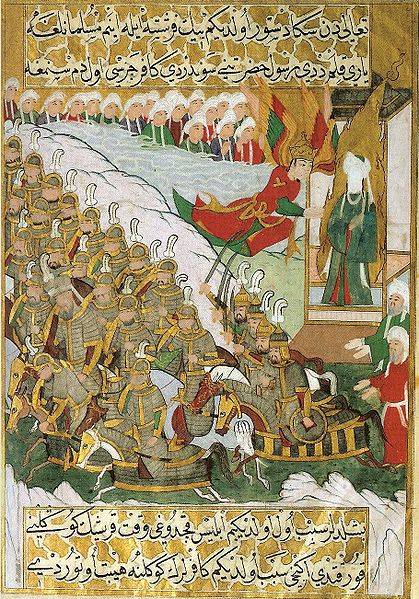
Mohammed at the Battle of Badr. Thumbnail of the XV century.
Thus, we see that the armies of the Arab East differed from the European ones in the first place by the fact that some had heavy weapons and others had light weapons. Costumes, similar to quilted caftans, can be seen on the "canvas from Bayeux." But they were also among the warriors of horse-drawn heat in Africa. Scaly (lamellar) shells and horse blankets had both Byzantine, and Iranian, and Arab cavalrymen, and it was during that era when the Europeans did not even think about all this. The main difference was that in the East, the infantry and cavalry were complementary to each other, whereas in the West there was a continuous process of crowding out the cavalry of the infantry. Already in the XI century, the infantrymen accompanying the knights were in essence merely servants. No one tried to properly train and equip them, while in the East, considerable attention was paid to the monotonous armament of troops and their training. The heavy cavalry was supplemented with light troops, used for reconnaissance and combat strings. Both there and here in the heavily armed cavalry served professional soldiers. But the western knight, although he was armed at the time more easily than the similar soldiers of the East, had much more independence, since in the absence of good infantry and light cavalry he was the main force on the battlefield.
The Prophet Mohammed exhorts his family before the battle of Badr. Illustration from the Universal History by Jami al-Tawarih, 1305 - 1314 (Collections Khalili, Tabriz, Iran)
In the same way as the European riders, the Arabian riders needed to be able to accurately strike the enemy with a spear, and for this it was necessary to train in the same way all the time. In addition to the European technique of attack with a spear at the ready, the eastern riders learned to hold a spear and with both hands at the same time, holding the reins in their right hand. Such a blow tore even double-layered mail shell, with the spear tip coming out of the back!
For the development of accuracy and strength of the strike, the game was played by a burgjas, during which the horsemen at full tilt lashed out at a column made up of many wooden blocks. It was necessary to knock out separate blocks with blows of copies, so that the column itself would not crumble.
Arabs besiege Messina. A miniature from the "History of the Byzantine Emperors in Constantinople from 811 to 1057 the Year, written by Kuropalat John Skilitsa." (National Library of Spain, Madrid)
But only by arming their similarity was by no means exhausted. The Arab knights, like their European counterparts, for example, had extensive land holdings, which were not only hereditary, but also granted them for military service. They were called in Arabic ikta in the X – XI centuries. turned entirely into military liens, analogous to the land holdings of knights of Western Europe and professional soldiers of many other states on the territory of Eurasia.
It turns out that the knightly class was formed in the West and in the East almost simultaneously, but for a long time they could not measure themselves with forces. The exception was Spain, where the border war of Christians with Muslims did not subside for a single moment.
October 23 1086, a few miles from Badajoz, near the town of Zalaka, the army of the Spanish Moors met in battle with the royal knights of the Castilian king Alfonso VI. By this time, feudal fragmentation reigned in the lands of the Arabs, but before the threat from Christians, the emirs of the south of Spain managed to forget their many years of enmity and called for help their African co-religionists. These warlike nomadic tribes were considered by the Arabs of Andalusia to be barbarians. Their ruler Yusuf ibn Texhuin seemed to the Emirs a fanatic, but there was nothing to be done, and they came out against the Castilians under his command.
1500 Sudanese Warrior Armor. (Higgins Museum of Armor and Weapons, Worchester, Massachusetts, USA)
The battle began with the attack of the Christian knightly cavalry, against which Yusuf put up infantry detachments of the Andalusian Moors. And when the knights managed to overturn them and drove to the camp, Yusuf listened to the news about it and only said: "Do not rush to their aid, let their ranks thin down even more - they, like Christian dogs, are also our enemies."
Meanwhile, the Almuravidian cavalry was waiting in the wings. She was strong both in her numbers and, above all, in discipline, which violated all the traditions of the knightly war with her group bouts and fights on the battlefield. The moment came when the knights, passionate about the pursuit, scattered across the field, and then Berber horsemen attacked from the rear and from the flanks. The Castilians, who were sitting on already tired and sunken horses, were surrounded and beaten. King Alfonso at the head of the squad from 500 riders managed to escape from the encirclement and with great difficulty escaped from the chase.
This victory and the subsequent unification of all the emirates under the rule of Yusuf made such a strong impression that there was no end to the jubilation of the Arabs, and the Christian preachers of the Pyrenees immediately called for a crusade against the infidels. For a full ten years before the widely known first crusade against Jerusalem, the crusader army was assembled, invaded the Muslim lands of Spain, and ... was again defeated there.
* The Caliphate is a Muslim feudal theocracy, headed by a caliph, a secular-religious ruler, who was considered the legitimate successor of Muhammad. The Arab Caliphate with its center in Medina existed only until the 661 year. Then the power passed to the Umayyads (661 — 750), who transferred the capital of the caliphate to Damascus, and from the 750 of the year to the Abbasids, who transferred it to Baghdad.
** The most ancient mention of chain mail is found even in the Quran, where it is said that God with the hands of Daoud softened the iron and at the same time said: “Make a perfect shell of it and connect it thoroughly with rings”. The Arabs and called the chain mail - armor Daoud.
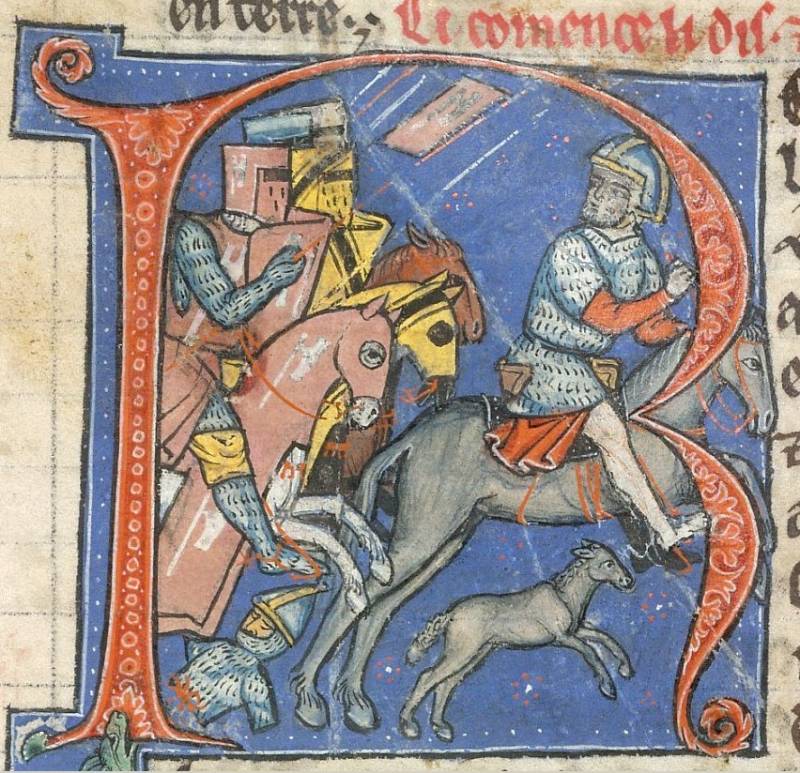
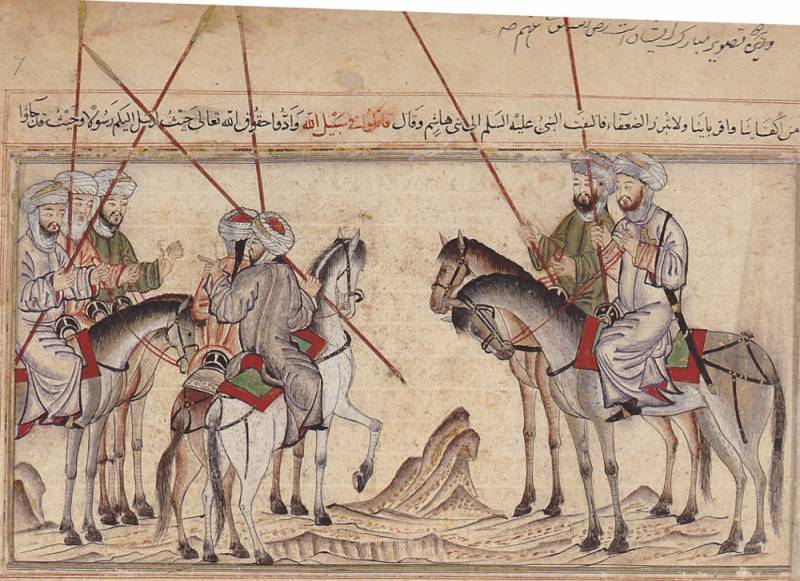
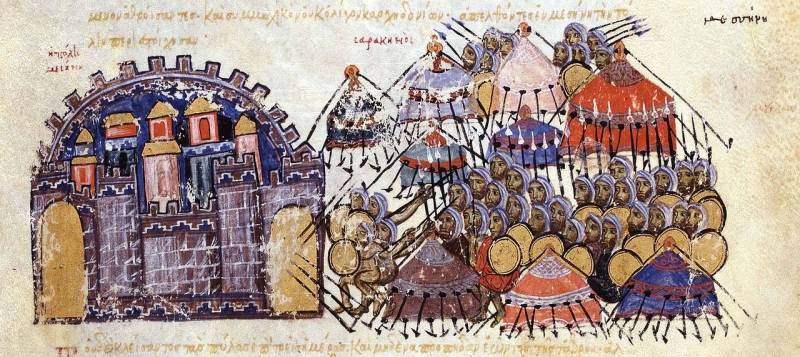
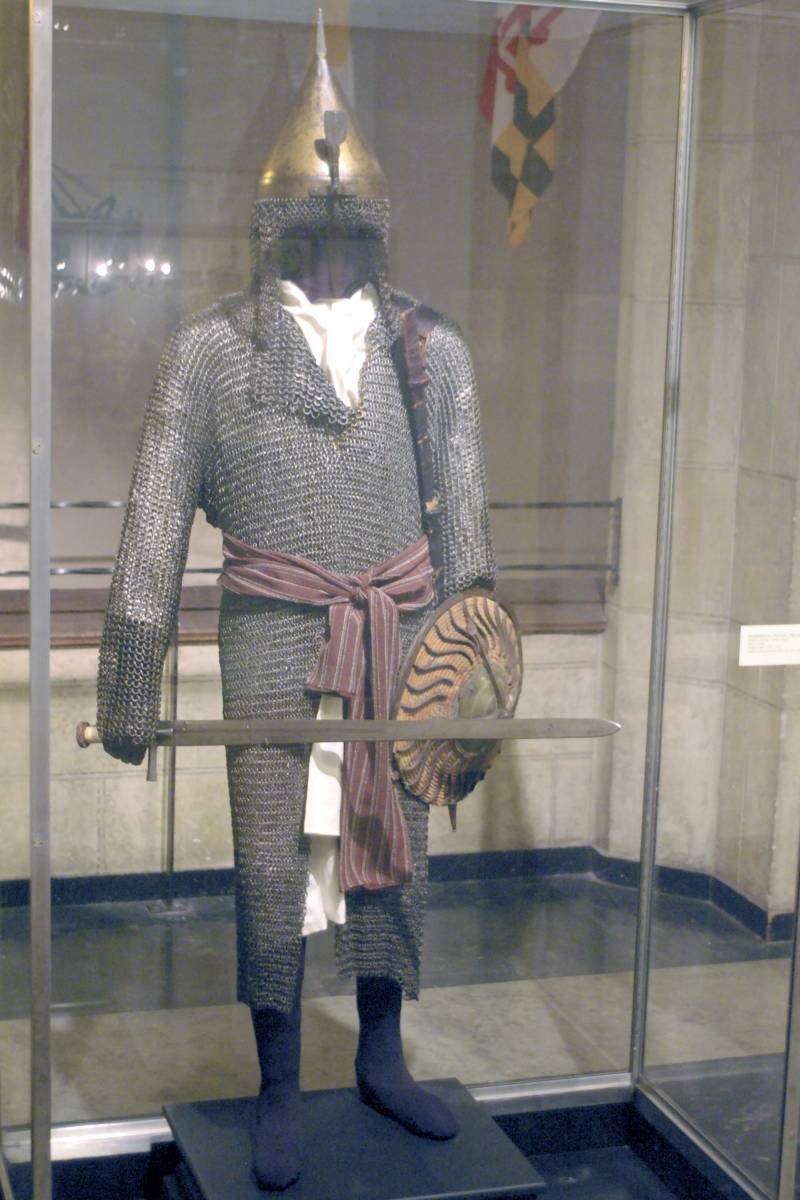
Information